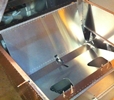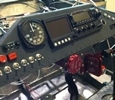


random user submitted photo
Glide Ratio
35 posts
• Page 1 of 4 • 1, 2, 3, 4
Glide Ratio
My aircraft, Sonex/ Rotax 912 ULS, is due to have its pre test flight inspection this coming (Australian) Saturday morning. One of the inspection forms calls for an, engine out, glide ratio.
I would like to enter a nominated (conservative) glide ratio that can be adjusted after flight testing - please advise me of your aircrafts glide performance.
My thanks in anticipation.
I would like to enter a nominated (conservative) glide ratio that can be adjusted after flight testing - please advise me of your aircrafts glide performance.
My thanks in anticipation.
- Skippydiesel
- Posts: 633
- Joined: Tue Jul 06, 2021 6:24 am
Re: Glide Ratio
Optimum conditions suggest 11:1. This number is also published in several web search results.
Lou Pappas
Phoenix, AZ
RV-7A (Building)
Waiex B Turbo
RV-8
Waiex Legacy 3300
Hiperlight SNS-9
Falcon Ultralight[/b]
Phoenix, AZ
RV-7A (Building)
Waiex B Turbo
RV-8
Waiex Legacy 3300
Hiperlight SNS-9
Falcon Ultralight[/b]
- pappas
- Posts: 338
- Joined: Wed Feb 15, 2017 11:27 am
Re: Glide Ratio
pappas wrote:Optimum conditions suggest 11:1. This number is also published in several web search results.
Thanks Pappas - looked on the Sonex site - no mention that I can find.
- Skippydiesel
- Posts: 633
- Joined: Tue Jul 06, 2021 6:24 am
Re: Glide Ratio
Edit: I removed my estimated performance from memory of 8.5:1 since I posted actual data further down that shows closer to 9.5:1.
I found this POH online that lists a best glide angle of 6 degrees which works out to 9.5:1.
https://www.sonex883.com/docs/Sonex%20p ... rating.pdf
My experience has been that the Cessna-172 seems to glide noticeably better.
I found this POH online that lists a best glide angle of 6 degrees which works out to 9.5:1.
https://www.sonex883.com/docs/Sonex%20p ... rating.pdf
My experience has been that the Cessna-172 seems to glide noticeably better.
Last edited by gammaxy on Wed Nov 16, 2022 11:02 pm, edited 1 time in total.
- gammaxy
- Posts: 593
- Joined: Wed Sep 04, 2013 9:31 am
Re: Glide Ratio
That's an interesting question. I am a long way from having the airplane ready for flight test. Do most people actually measure Vx, Vy and glide performance during flight test? Or, do most people just kind of do a subjective evaluation of how the plane flies and call that good? The relevant test cards on the EAA recommended test program would be cards #7 and #8. Both The Sonex site and Wikipedia list 11:1 for L/D.
Last edited by fastrichard on Wed Nov 16, 2022 7:30 am, edited 1 time in total.
- fastrichard
- Posts: 8
- Joined: Wed Sep 01, 2021 9:13 pm
Re: Glide Ratio
I suspect hat there is a significant difference between engine out and engine idle glide ratio.
I hope it never happens but the engine out glide ratio is the important one, as this is what will give the potential to reach a suitable (selected) forced landing site rather than a crash (no option) landing. The former being the most likely to be survivable.
I hope it never happens but the engine out glide ratio is the important one, as this is what will give the potential to reach a suitable (selected) forced landing site rather than a crash (no option) landing. The former being the most likely to be survivable.
- Skippydiesel
- Posts: 633
- Joined: Tue Jul 06, 2021 6:24 am
Re: Glide Ratio
The little charts in the Cessna Owners Manuals are quite conservative. A blend of reality, flight testing and the company attorneys wanting to be a little conservative (source - Aviation Attorney Rick Dirden who used to work for Cessna).
I can tell you I used to "beat" the Cessna chart with my 150 relatively easily. But in a 150 - Vg and Vminsink are within a knot of each other with very little difference for load. Stopped propeller compared to windmilling improves the glide substantially. On the day it mattered - I managed a glide of 12 miles when the little chart said I had 10 miles in the "glide tank" and made the runway with 1,000ft to spare.
--
Testing in my Legacy Sonex - the wing is MUCH more critical of angle of attack and loading. Flying full fuel, just me - so about 150lb of usable remaining and windmilling prop. I measured 8.8:1 fairly consistently at 60KIAS. The sink rate is in the area of 500fpm. BUT it requires a HIGH degree of concentration to maintain that angle of attack and as you are likely to be engaged with other things like trying engine restarts, looking for a spot to land and making calls - I use 8:1 as a "real world" number. Even then - when I practice "cold" having not done it for a bit - sometimes I will only achieve 7:1.
To my mind "real world" is much more important than a measured "perfect" value - so I am back to the Cessna chart in terms of thinking. "Most people should manage this - though the plane will do better". To be clear - I don't use the Cessna chart!! Just the mindset.
Rule of thumb for quickly establishing Vg in an emergency - in level flight - put the chord line of the wing parallel to the horizon. Gets you close enough - and helps when you are having to look outside - rather than at the instruments.
I can tell you I used to "beat" the Cessna chart with my 150 relatively easily. But in a 150 - Vg and Vminsink are within a knot of each other with very little difference for load. Stopped propeller compared to windmilling improves the glide substantially. On the day it mattered - I managed a glide of 12 miles when the little chart said I had 10 miles in the "glide tank" and made the runway with 1,000ft to spare.
--
Testing in my Legacy Sonex - the wing is MUCH more critical of angle of attack and loading. Flying full fuel, just me - so about 150lb of usable remaining and windmilling prop. I measured 8.8:1 fairly consistently at 60KIAS. The sink rate is in the area of 500fpm. BUT it requires a HIGH degree of concentration to maintain that angle of attack and as you are likely to be engaged with other things like trying engine restarts, looking for a spot to land and making calls - I use 8:1 as a "real world" number. Even then - when I practice "cold" having not done it for a bit - sometimes I will only achieve 7:1.
To my mind "real world" is much more important than a measured "perfect" value - so I am back to the Cessna chart in terms of thinking. "Most people should manage this - though the plane will do better". To be clear - I don't use the Cessna chart!! Just the mindset.
Rule of thumb for quickly establishing Vg in an emergency - in level flight - put the chord line of the wing parallel to the horizon. Gets you close enough - and helps when you are having to look outside - rather than at the instruments.
Graeme JW Smith
-

GraemeSmith - Posts: 939
- Joined: Sat May 18, 2019 8:58 am
- Location: RI
Re: Glide Ratio
Jeff Schultz posted data:
http://sonex604.com/
I used his cards to fly Vx and Vy. I haven't done the glide performance yet. But you could use his logged numbers to build a glide ratio chart.
http://sonex604.com/
I used his cards to fly Vx and Vy. I haven't done the glide performance yet. But you could use his logged numbers to build a glide ratio chart.
Bryan Cotton
Poplar Grove, IL C77
Waiex 191 N191YX
Taildragger, Aerovee, acro ailerons
dual sticks with sport trainer controls
Prebuilt spars and machined angle kit
Year 2 flying and approaching 200 hours December 23
Poplar Grove, IL C77
Waiex 191 N191YX
Taildragger, Aerovee, acro ailerons
dual sticks with sport trainer controls
Prebuilt spars and machined angle kit
Year 2 flying and approaching 200 hours December 23
-

Bryan Cotton - Posts: 5034
- Joined: Mon Jul 01, 2013 9:54 pm
- Location: C77
Re: Glide Ratio
I wrote a script to parse through most of my Phase 1 data, find periods of unaccelerated flight and plot points showing engine RPM, IAS, and climb rate.
The data is very raw and I made it many years ago. It includes the full range of weights. A huge range of altitudes, etc. I'm hesitant to share it because of these caveats, but I like it because it shows a range of possible values with little room for exaggeration.
I've overlaid some glide ratios on my old plot. Notice how they compare to the blue points at idle. On my airplane, 11:1 would be an outlier. There's a pretty dense set of points on the 9:1 line probably from most of my glide testing and power off landings at <3500 feet. If you adjust IAS to TAS, these points probably move right a bit possibly to 9.5:1 or so. It's likely the lower blue points are from long descents from high altitudes and should have significant higher true airspeed, so I think they can be ignored.
The data is very raw and I made it many years ago. It includes the full range of weights. A huge range of altitudes, etc. I'm hesitant to share it because of these caveats, but I like it because it shows a range of possible values with little room for exaggeration.
I've overlaid some glide ratios on my old plot. Notice how they compare to the blue points at idle. On my airplane, 11:1 would be an outlier. There's a pretty dense set of points on the 9:1 line probably from most of my glide testing and power off landings at <3500 feet. If you adjust IAS to TAS, these points probably move right a bit possibly to 9.5:1 or so. It's likely the lower blue points are from long descents from high altitudes and should have significant higher true airspeed, so I think they can be ignored.
- gammaxy
- Posts: 593
- Joined: Wed Sep 04, 2013 9:31 am
Re: Glide Ratio
General rule of thumb for my legacy Waiex with Jab3300 and a weight around 1070 lbs (me and full fuel load) is 1 mile glide for each 1000' above the ground with an idling prop for about about 10:1 - and probably 3/4 of that (about 8:1) with a dead engine. This at 70mph.
I figure that's about all I'll actually be able to remember given the situation..../
Lorin
I figure that's about all I'll actually be able to remember given the situation..../
Lorin
- ldmill
- Posts: 90
- Joined: Mon Nov 21, 2011 2:30 am
35 posts
• Page 1 of 4 • 1, 2, 3, 4
Who is online
Users browsing this forum: No registered users and 5 guests







